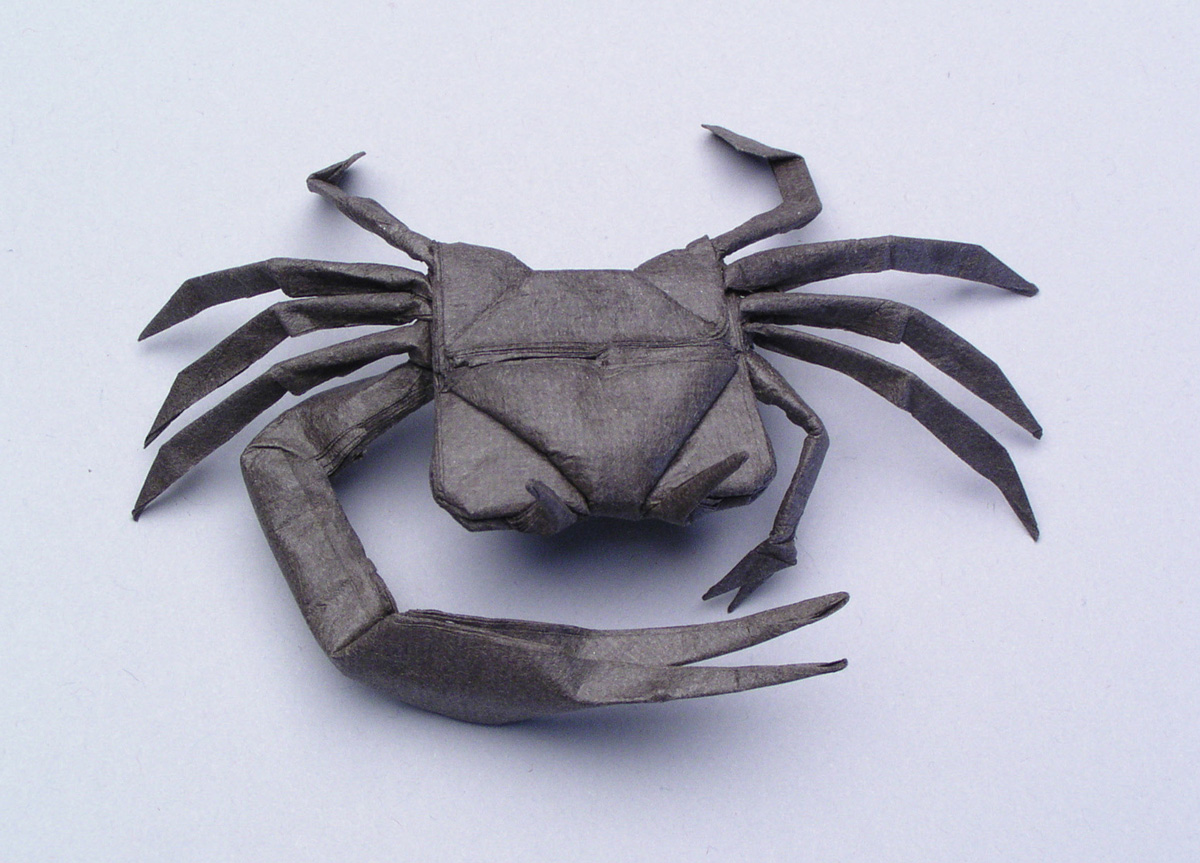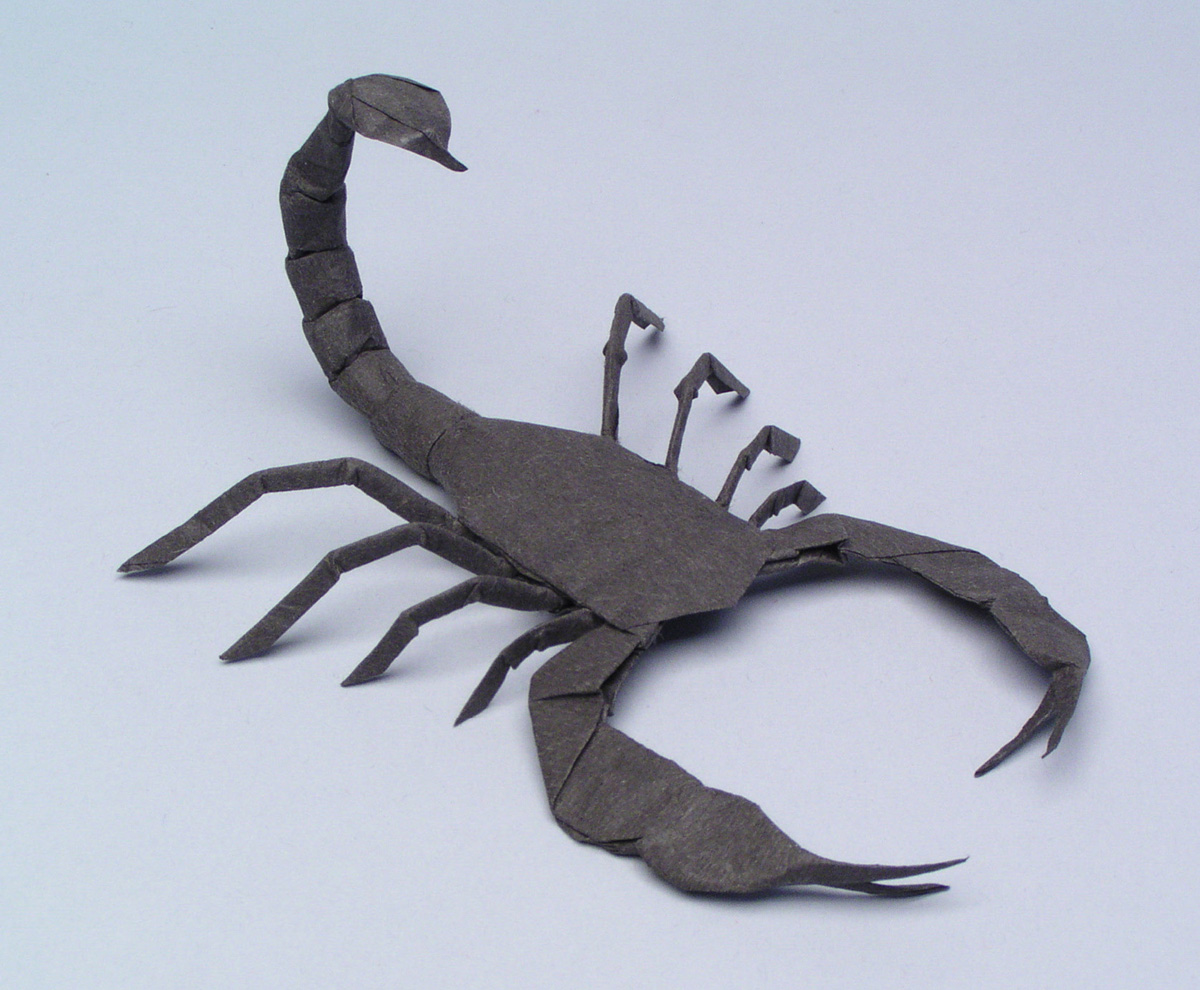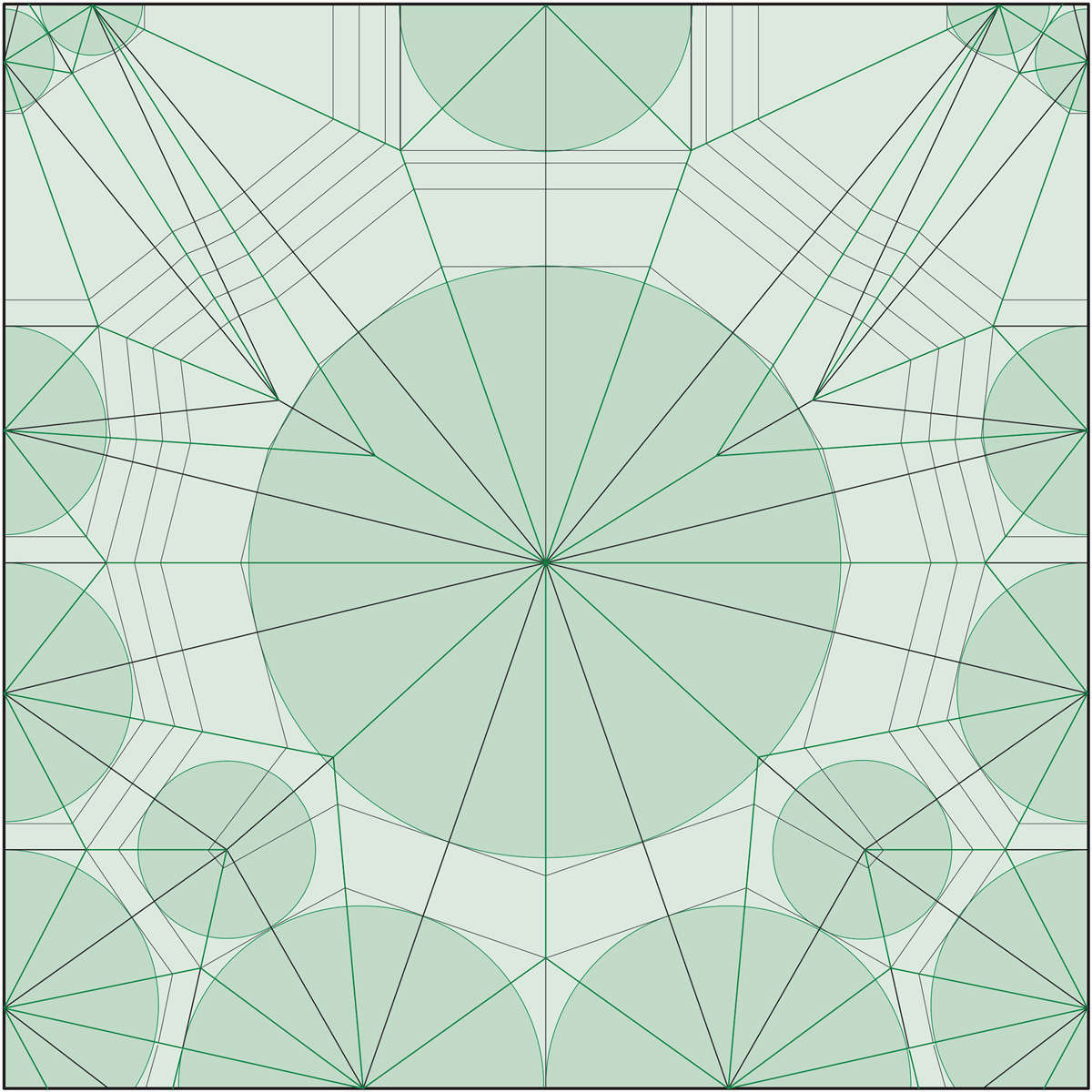The Mathematics of Paper Folding: An Interview with Robert Lang
Adventures in computational origami
Margaret Wertheim and Robert J. Lang
Robert Lang is a pioneer in the emerging field of computational origami, a branch of mathematics that explores the formal properties and potentialities of folded paper. Like the study of knots, pioneered by mathematicians and physicists in the late nineteenth century, computational origami and its practical offshoot origami sekkei or “technical folding,” turn out to have a surprising range of applications to real world problems, from working out how to fold up stents so they can be threaded into arteries, to designing thin-film telescopes that are packed into the hold of a space shuttle. Lang is the inventor of the TreeMaker computer program, which allows him to design and calculate crease patterns for a wide range of origami models—including intricate insects, crustaceans, and amphibians. He has been one of the very few Western columnists for the Japan Origami Academic Society and is the author of eight books, including Origami Design Secrets: Mathematical Methods for an Ancient Art. Lang received a doctorate in physics from Caltech and spent twenty years as a laser physicist before becoming a full-time paper folder. Margaret Wertheim, Director of the Institute for Figuring, interviewed him in October 2004, when Lang was in Los Angeles to deliver a talk at the Institute.
Cabinet: You spent two decades working as a physicist. What made you decide to give that up and become a professional origamist?
Robert Lang: I’ve been interested in origami my entire life. In fact, my interest in physics started sometime in college, but I’ve been folding since I was a child. Through the years I was a professional physicist, I found that the tools I had learned doing physics and engineering—the mathematics and the approach to breaking down problems and studying the underlying theory—could be applied to origami as well. So that helped me to develop my origami art to a fairly high level. It just grew, and the number of different facets I was involved in—the art, the science, the underlying mathematics, the applications to technology—eventually got to a point that I felt I could occupy myself full-time doing origami, consulting, lecturing, and making art. I made that change three years ago and never looked back.
Can you explain what the term “technical folding” means?
It applies to origami that’s complex enough that it probably wasn’t discovered by accident. The word “technical” really refers to techniques; you’re using specific techniques for designing specific features. And while it had its roots as early as the 1970s, it really blossomed in the 1990s when various origami artists developed mathematical and geometrical principles for folding—they developed an understanding of how the crease patterns turn into geometric shapes in the folded object. So if they needed to make an object that has five parts (arms, legs, wings, and whatever), they could start to figure out what type of geometric shapes to put into the crease pattern that would assemble into those parts. In effect they developed a set of building blocks for origami.
And does this enable you to do things that weren’t possible with traditional origami techniques?
Pretty much. The traditional origami designs were generally simplified and abstract, and when people tried to do subjects that had very complicated shapes—the case-in-point being insects and arthropods which have lots of long, skinny legs—they found that traditional folding styles weren’t able to give them the features they wanted. And even if they got an insect with, say, six legs, they had to be sort of stumpy little points because they didn’t know how to get really long, skinny points. What technical folding allowed us to do was to create all the features with all the dimensions that we really wanted to capture.
So what creatures have you been able to develop with these techniques?
The things that drove me to develop my techniques were cervids, horned animals—deer, elk, moose, antelope, and the like. White-tailed deer, moose, and elk all have different branching patterns in their antlers and I wanted to be able to make each species. That required one to specify the lengths of the points, the numbers of points, and how they’re connected to each other with a great degree of precision. But another class of subjects that this worked really well for was insects and the broader class of arthropods—everything from crabs and lobsters to scorpions and spiders.

In addition to your own designs you also do origami consulting. Whom do you consult for?
National laboratories like Jet Propulsion Laboratory and Lawrence Livermore Laboratory and a variety of commercial companies that are doing product development in areas like medical devices and packaging.
What sort of packaging requires a professional origamist?
Typically it’s a package that has some dual purpose. One purpose would be when you have to enclose several different objects and you want to use the same container for all of them, so that it has to fold between several different states. I don’t know if they need a professional origamist, but someone who has been folding for twenty years knows a lot of different structures. Usually I manage to come up with something they haven’t seen before.
You’ve also helped the Lawrence Livermore Lab develop a space-based telescope.
The idea was to make a telescope with a 100-meter aperture that could be deployed in space, meaning the main lens of the telescope would be approximately a football field across. The lens itself would be a diffractive lens, a pattern of grooves formed on a thin, plastic substrate, like ones used in overhead projectors. So now they had the problem of a 100-meter sheet of plastic that needs to be taken into space and the only way we have to take things into space is a rocket or a space shuttle, which are only a few meters across. That pretty much stipulates some form of folding. They built a five-meter prototype based on a design I proposed that was very successful in their tests.
That suggests there is a general class of subjects to which origami is applicable: something that needs to be folded up in order to ship it or launch it, but later on, its end state has to be much bigger.
That’s a pretty good description. Whenever you have an object that exists in a large state that is generally a surface, something that’s roughly flat, and it also has to exist in a much smaller state, usually for transportation, then origami plays a role. In the space program, that shows up in things like folded lenses, solar sails, various types of collapsible antennae, and collapsible shrouds or shields. In the area of medicine, there are various types of implants, such as stents, that go into the body, and which need to be put in through as small a hole as possible. Or maybe it goes in through a blood vessel. Again, folding is a way of collapsing the structure down so it can be threaded through an artery or inserted into an incision and expanded once it’s close to its final resting place.

Haven’t origami techniques also been used for working out how to pack airbags into steering columns in cars?
Actually, in that case it was for a computer simulation of an airbag rather than the actual airbag. If you’re simulating an airbag, you need to know where the crease-lines form when the airbag is collapsed. In this project, a German firm, EASi Engineering, was developing a software tool for simulating airbags, so that automotive manufacturers could figure out whether a certain airbag design would work without having to actually crash a bunch of Mercedes. They came to me because I had published some papers about algorithms for folding things flat, and it turned out that one of these algorithms was right for their needs.
What is the technical problem regarding how to fold things flat?
Mathematically the problem is very simple. Given a polyhedral surface, can you construct creases so that when you fold on all the creases, all of the faces of the polyhedra lie on the same plane. That can be reduced to another problem: given an arbitrary polygon, can you construct creases so that when you fold on all the creases, all of the boundaries of the polygon lie along a single straight line? That has a purely mathematical solution that is of interest maybe only to mathematicians, yet it turns out to have these practical applications as well.
What other mathematical problems are technical folders interested in?
I think one of the most vibrant is the question of what distances and shapes can be constructed just by folding alone, without doing any measuring. That harkens back to an ancient problem in pure mathematics—what’s called compass and straight edge construction. This goes back to the early Greeks, who wondered what shapes and distances could be constructed using just a compass and a straight edge for making arcs and drawing straight lines. And there is an origami analogue of that problem, which asks what distances and shapes you can construct just by making folds in a sheet of paper without being allowed to measure any distance with a ruler. It turns out that the field of shapes you can construct with folding is richer than what you can construct with compass and straight edge.
For example, just with folding you can solve the problem known as trisecting the angle—this means dividing a given angle into thirds. For 2000 years, people tried to find a way to do this with a compass and unmarked ruler until finally in the late nineteenth century mathematicians proved that it could not be done at all. But in the 1980s, a French folder named Jacques Justin and a Japanese folder named Tsune Abe independently showed how it could be done with origami. Mathematically, trisecting an angle is the equivalent of solving a particular cubic equation—an equation involving x to the power of three. Using straight edge and compass you can only solve equations with x to the power of 2. Once cubics were done with origami, the question was naturally asked, “Well, can you solve higher order equations with folding?” Just recently I have shown that in fact origami can solve fifth-order equations—ones involving x to the power of 5. That’s pretty interesting, I think.
Are there any practical applications for these constructions?
Absolutely none that I can think of outside origami—it’s appreciated purely for the mathematical beauty.

One area in which I gather technical folding is proving useful is one of the major problems in biology. We know that with proteins often the most important thing about them is not the chemical composition, per se, but the shape they eventually fold up to.
There’s both relevance and differences here, because paper folding is two-dimensional and a protein is roughly a one-dimensional shape, a linear chain with a bunch of joints in the chain. Protein folding is actually much more complicated than paper, in that folds can happen only at certain angles and there are bits that stick together if you get them close. There are also other molecules jostling around that can knock the protein about as it’s folding. But the fundamental theory of folding is the same, and if youcan develop general concepts that apply across dimensions—from one-dimensional to two-dimensional, and even higher-dimensional problems—then the results that you derive are going to be applicable to these very fundamental issues like protein folding and biological activity.
It reminds me of another branch of mathematics—knot theory. In the late nineteenth century, mathematicians and physicists became interested in how many different ways there were to tie a knot. And it’s turned out in the late twentieth century that some physicists believe knot theory might explain the nature of subatomic particles. Mathematicians seem to have this way of taking what seem to be unbelievably trivial things and developing from them incredibly powerful abstract techniques. Do you think paper folding may one day have some relevance to our understanding of fundamental physics?
Whenever you’re developing new mathematics, there’s always that possibility. The hallmark of these sorts of surprise applications is that they always turn out to have been a surprise. There is a great example of this that is close to origami. In technical origami when we’re designing complicated forms like many-legged insects, we use a technique called “circle packing” which basically asks the question how can you efficiently pack a bunch of circles into various shaped containers. Now over the years mathematicians have also studied how to pack spherical objects into higher-dimensional spaces and how close a packing you can get. Well, it turned out that in twenty-four dimensions there is a particularly dense packing. That sounds about as irrelevant an idea as you can get, except it turns out that twenty-four-dimensional packing gives a very dense compression algorithm for sending data. So using this twenty-four-dimensional sphere packing result has become the basis for developing a very efficient code for twenty-four-bit binary words. Now, who would have predicted that?
One thing that’s fascinating about technical folding is that it’s both a physical and an intellectual process. You have to have an analytical mind to design the structures, but then you also need to have a great deal of practical skill in terms of folding them, as they are actually quite difficult to make.
I think of it like music. In fact there are a lot of analogies between origami and music. You can compose both simple melodies and symphonies with a lot of different instruments and themes moving in and out. It’s the same with origami. There are simple beautiful folds, in the same way that there are simple melodies, but if you’re trying to do these very complicated structures, you need practice to get good at it.
Is there a limit to the complexity of the models you can make with origami?
Mathematically, there’s no limit. Theoretically, you can take a finite sheet of paper and you can fold a star shape that has an infinite, arbitrarily large perimeter—10,000 miles, if you like. That shape’s points would have millions of layers in them. So, that’s a problem you can do mathematically but not in practice, because, in the real world, paper has a finite thickness and you’re limited in what you can do by the tensile properties of the paper. In the last five to ten years, as people have designed more complex figures, their ability to fold these figures has also been enhanced by improvements in the field of papermaking. So you can now get extremely thin, strong papers that can be folded into shapes that probably couldn’t have been folded fifteen years ago.
You’ve written a computer program, called TreeMaker, that will work out very complicated designs and calculate the crease pattern. Yet traditional folders won’t even allow the use of a ruler to make measurements. Is it somehow cheating to bring a computer into the origami design process?
There are people who get deeply nervous about the idea of using a computer as a tool in design. The general consensus, I think, is that when it comes to using a ruler, it’s fine if you’re using it for designing the model, as long as you don’t make the person trying to follow the instructions use a ruler. Long before I wrote my computer program, and even today, I still use a pencil and paper to sketch out and calculate a draft of the crease-pattern. In that sense, the computer is no more of a tool than a pencil and paper. I’ve done designs where I’ve intentionally asked the folder to measure with a ruler just because it was a bit provocative, but in my own folding I don’t consider a design to be finished until I have a sequence that I can do with just with a square of paper and my hands, not using any devices.
Robert J. Lang has been a scientist, engineer, and inventor in lasers and fiber optics, but has had a lifelong interest in the art of origami, a field in which he is recognized worldwide, both for his many compositions and sculptures, and for his investigations into the relationships between origami, science, and mathematics. He lives in northern California.
Margaret Wertheim is the founder of the Institute For Figuring in Los Angeles, an organization devoted to the public understanding of figures and the vast range of figuring techniques that humans have developed through the ages (www.theiff.org). She is currently working on a book about the role of imagination in theoretical physics.